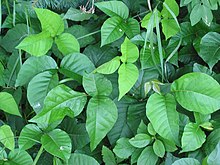
Back دفاع النباتات ضد العواشب Arabic Mecanismes de defensa de les plantes contra els herbívors Catalan Pflanzliche Abwehr von Herbivoren German Plant defense against herbivory English Defensas vegetales contra la herbivoría Spanish دفاع گیاه در برابر علفخوار Persian Défense des plantes contre les herbivores French התגוננות צמחים מטריפה HE Pertahanan tanaman terhadap herbivora ID Difesa vegetale contro gli erbivori Italian


Defence against herbivory describes plant defences to avoid being eaten. There are many adaptations which improve the survival and reproduction of plants by reducing the effect of herbivores.
Many plants produce chemicals which change the behaviour, growth, or survival of herbivores. These chemical defences can act as repellents or toxins to herbivores, or reduce plant digestibility. Some plants, known as hyperaccumulators, specialise in storing heavy metals which are toxic to animals.
Some plants encourage the presence of natural enemies of herbivores, which in turn protect the plant. Some plants provide a home for ants which defend the plant strongly.
Other defensive strategies used by plants include escaping or avoiding herbivores in time or in place. They may grow where plants are not easily found or got at by herbivores. They may grow when herbivores are not around. Herbivores may get diverted towards non-essential parts, or a plant may be able to recover from the damage caused by herbivory.
Each type of defence can be either constitutive (always present in the plant), or induced (produced in reaction to damage or stress caused by herbivores). Plants can and do react to damage.[1]
Historically, insects have been the most significant herbivores, especially the larvae of insects. The evolution of land plants is closely associated with the evolution of insects. While most plant defences are directed against insects, other defences have evolved that are aimed at vertebrate herbivores, such as birds and mammals.
The study of plant defences against herbivory is important, not only from an evolutionary viewpoint, but also because these defences can be used in agriculture, including human and livestock food sources.
- ↑ Boyd, Jade 2012. A bit touchy: Plants' insect defenses activated by touch. Rice University. [1] Archived 2012-05-12 at the Wayback Machine
© MMXXIII Rich X Search. We shall prevail. All rights reserved. Rich X Search